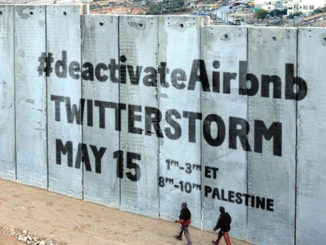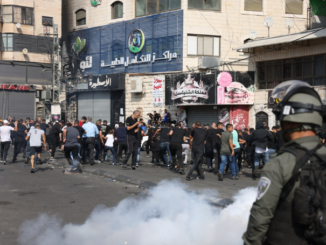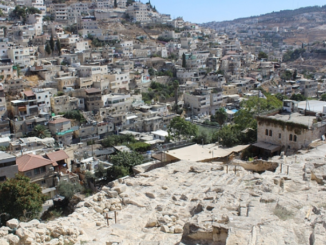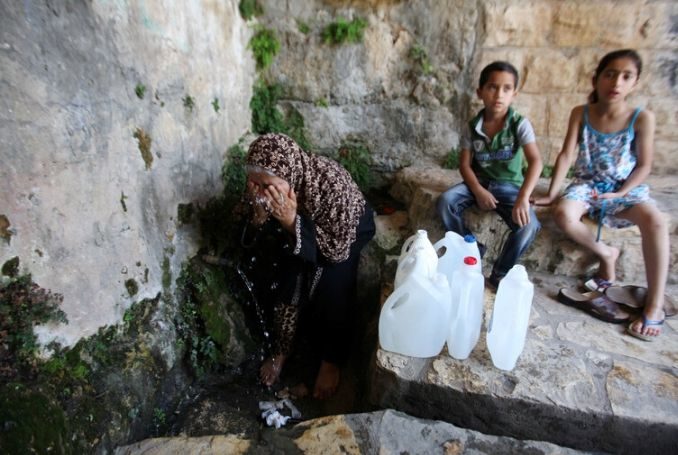
Last week, the Palestinian Water Authority blasted Israel for significantly reducing the amount of water allotted to the West Bank. “We are facing this crisis as we enter the summer season, a time of the year when people are usually in need of more, not less water,” PWA leader Mazen Ghneim was quoted as saying.
In my neighborhood in Ramallah, every year during the summer months, we hardly have water in the pipes. Water runs only one day a week. So, all the households must follow the water distribution schedule to plan their house activities such as doing the laundry and house cleaning. Some Palestinian communities in the West Bank are linked to “joint” water networks that serve illegal Israeli settlers. During the dry summer months, water valves leading to the adjacent Palestinian communities are routinely shut off by Israeli authorities, so that the settlers do not suffer water shortages.
The water shortage in the Palestinian territories is not a nature-related water crisis, but rather a result of the Israeli occupation which exploits over 85% of the water resources.
Facts and Figures
Israel controls the main three trans-boundaries aquifers in the occupied Palestinian territories. The first and the biggest one is the West Bank (mountains) aquifer which is fed by rainfall and generates 679 mcm of water per year. The second is the Jordan river which provides Israel with an estimated 450 mcm per year. Palestinians are denied access and supply of its water. The third is the coastal aquifer which generates 450 mcm of water for Israel and 55 mcm for Gaza.
Palestine has a good precipitation rate. Ramallah, for instance, has an annual rainfall average of 615 millimeters which is almost as much as London at 620 mm.
According to the Palestinian water authority report of 2012, around 784 mcm of rainfall is estimated to have recharged the groundwater systems in the West Bank and the Gaza Strip. However, Palestinians are allocated only 375 mcm of that groundwater, while Israel consumes 2,346 mcm annually.
The Oslo Agreement
The water problem started from the beginning of the Israeli occupation of Palestine but was exacerbated with the Oslo II interim agreement between the PLO and the Israeli government in 1995. The Oslo Agreement stipulated “the equitable utilization of joint water resources for implementation in and beyond the interim period.” But in reality, this has never happened.
The agreement which was supposed to be an interim period of five years bounded the development of Palestinian water resources and was framed on the assumption that Palestinian water needs were 70–80 mcm per year and that the interim water development must be managed through a Palestinian-Israeli mechanism. The topics of ‘common interest’ (water being one) would be further delineated under the permanent status negotiations.
The failure to reach a permanent agreement has meant the inequitable distribution of the West Bank groundwater resources with 15% allocated to the Palestinians and 85% to Israel.
As indicated in the Oslo Agreement, a Joint Water Committee (JWC) was established to oversee all water and wastewater related projects in the West Bank. JWC is made up of an equal number of representatives of Israel and the Palestinian Authority, respectively, and decisions are made by consensus. This gave Israel a veto power over all Palestinian water resource projects and blocked any request by the Palestinians to drill a new well. Wells built or rehabilitated without Israeli-issued permits are systematically destroyed by the Israeli occupation forces.
Water Apartheid
While the Palestinian communities are facing drought and water shortages, the Israeli settlements – located in the same geographical area – are enjoying an abundance of water supplies, allowing settlers to fill their swimming pools and irrigate their gardens and fields. The lack of access to adequate quantities of water necessary for livestock herding and food production leaves Bedouins, livestock owners and farmers particularly vulnerable.
Israeli agricultural settlements in the West Bank, particularly those in the Jordan Valley, enjoy up to 6 times the amount of water of the nearby Palestinian communities. In the Palestinian town of Tubas, the consumption rate is 30 liters per person per day. However, residents of the nearby illegal Israeli settlement of Beda’ot, consume around 401 liters per day, according to B’Tselem.
While the Palestinian population has doubled, water availability has decreased. According to the World Bank report of 2018 “With the West Bank and Gaza population of approximately 4.8 million growing at an average annual rate of 2.8 percent, the domestic supply gap is projected to be about 152 and 135 million cubic meters respectively”.
Israeli hydro-hegemony has left Palestinians with a deficit water budget. They have been forced to purchase from Israel around a quarter of domestic water supplies to make up for this deficit.
According to the Palestinian Bureau of Statistics, the daily per capita water consumption rate is around 88 liters. By comparison, the daily per capita water consumption in Israel is 257 liters. The World Health Organization (WHO) recommends 100 liters of water per capita per day as a minimum. Palestinian consumption is less than the minimum.
In the Gaza Strip, the water situation is even worse. The severe lack of water caused by the Israeli brutal blockade since 2007, has led to a heavy reliance on the underlying portion of the Coastal aquifer as Gaza’s only water supply.
The 2 million inhabitants extracted about 180 mcm in 2017, but this quantity is obtained via unsafe pumping that jeopardizes the sustainability of the source, while the total recharge is only one-third of extraction. The direct consequences of over pumping are seawater intrusion and uplift of the deep brine water; as a result, 97% of the water is undrinkable and does not match WHO quality standards of accepted guidelines for potable water resources.
Annexation Plan
Israel is controlling the two main Palestinian water resources in the West Bank (the Jordan River basin in the east and the western mountain aquifer) which supply Israel with about 900 million cubic meters of water annually.
Through the annexation of the West Bank areas expected this summer, Israel aims to keep the West Bank aquifers behind the new Israeli borders by retaining control of the settlement blocks adjacent to the basins, in particular, the Jordan Valley and the Salfit area where my hometown of Qira is located.
That annexation will perpetuate the high Israeli water-consumption levels while denying basic Palestinian needs and force Palestinians to depend on Israel for water, thus preserving the status quo of a dramatic unjust division of water resources, dimming any hope for a viable Palestinian state and peace in the region.
– Fareed Taamallah is a Palestinian journalist, a farmer, and a political activist based in Ramallah. He contributed this article to The Palestine Chronicle.
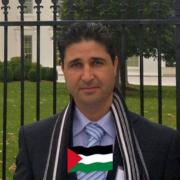
– Fareed Taamallah is a Palestinian journalist, a farmer, and a political activist based in Ramallah. He contributed this article to The Palestine Chronicle.



